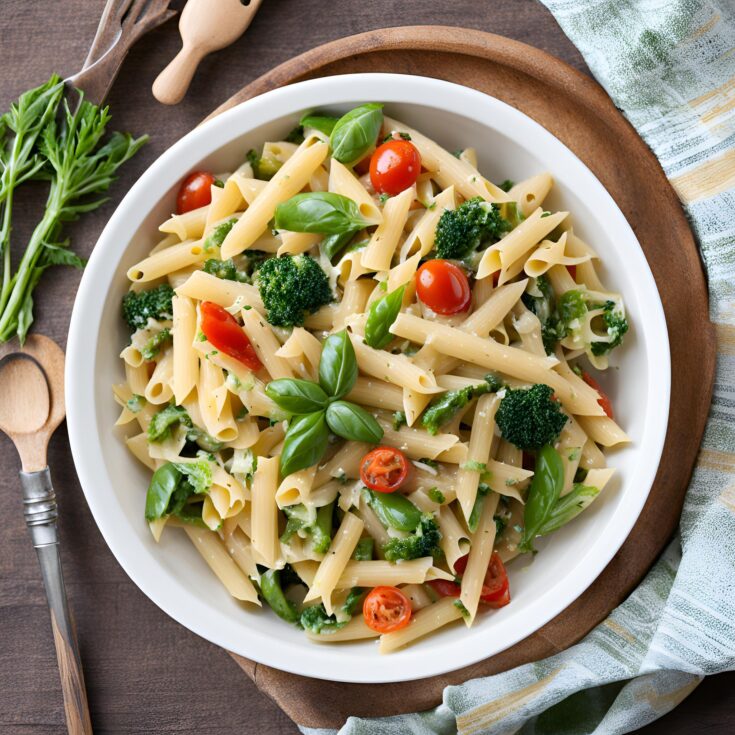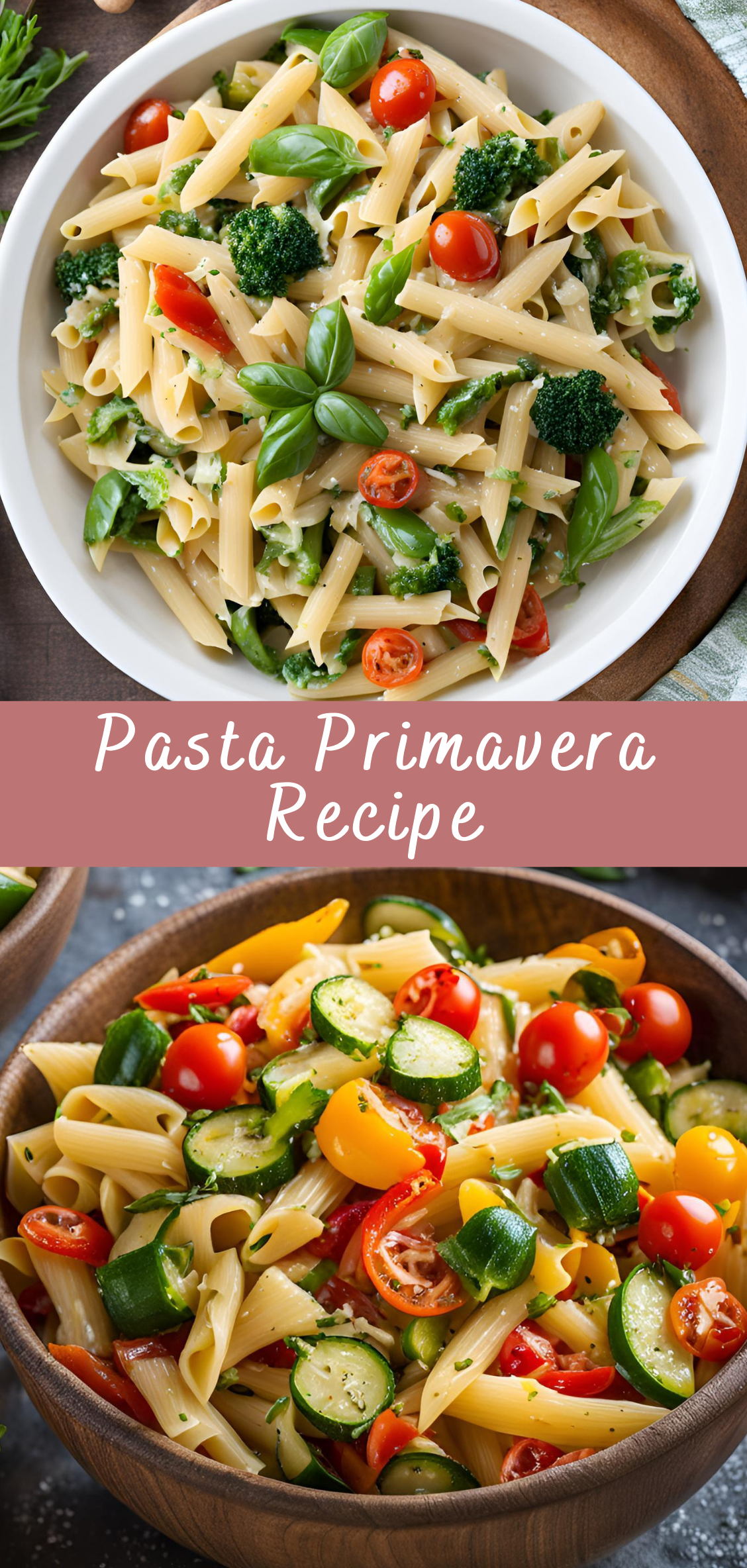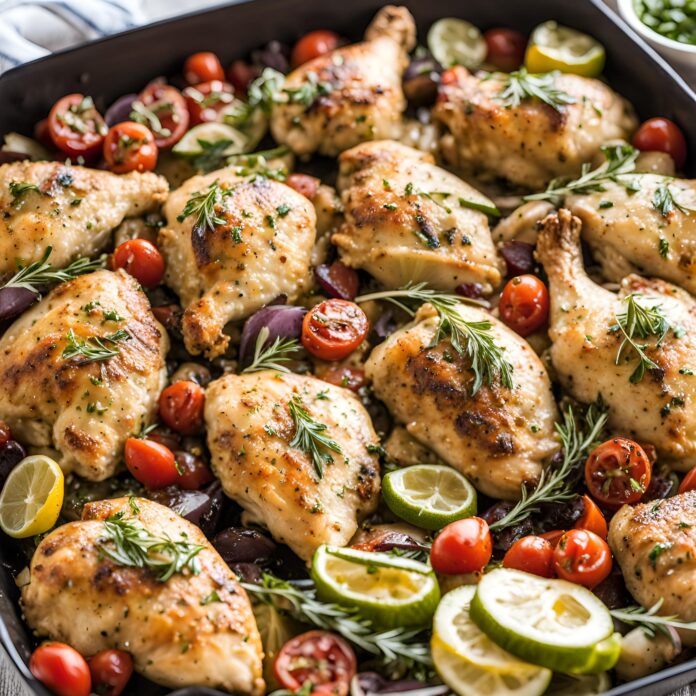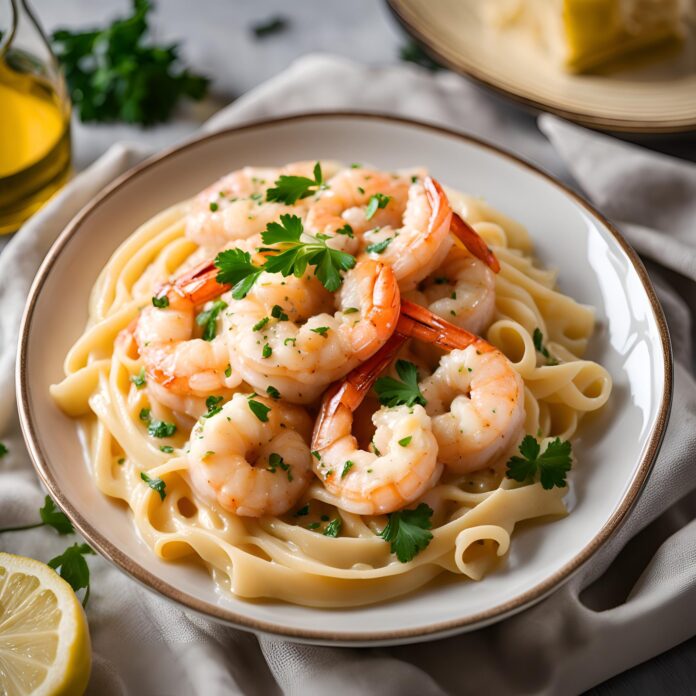Pasta Primavera Recipe
Pasta Primavera is a light, vibrant Italian-American dish that celebrates the bounty of fresh vegetables and the rich taste of pasta. This dish, with its bright colors and fresh flavors, is the perfect meal to enjoy during the spring and summer months when vegetables are in season. While there are various versions of Pasta Primavera, the traditional recipe is made with seasonal vegetables sautéed in olive oil, garlic, and herbs, and then tossed with pasta and often finished with cheese or a drizzle of olive oil.

The beauty of Pasta Primavera lies in its versatility. You can customize it with different vegetables, herbs, or cheeses based on your preferences, and it can easily be made vegetarian, vegan, or gluten-free to suit different dietary needs.
This extensive guide will cover everything you need to know to prepare the perfect Pasta Primavera. From step-by-step instructions to serving suggestions and tips, by the end of this, you will have a full understanding of how to create this delicious and adaptable dish.
Introduction to Pasta Primavera
Pasta Primavera, which translates to “spring pasta” in Italian, is a dish that highlights the seasonal bounty of fresh vegetables. It was popularized in the 1970s in the United States, especially in New York City, where it became a staple at Italian-American restaurants. The dish is typically made by sautéing a variety of vegetables such as bell peppers, zucchini, cherry tomatoes, peas, and asparagus in olive oil and garlic, and then tossing them with cooked pasta. The vegetables provide a fresh, light contrast to the rich and satisfying pasta, creating a perfectly balanced dish.
Though Pasta Primavera has its roots in Italian-American cuisine, it has become a global favorite due to its versatility. The vegetables used can be adjusted depending on the season and personal taste, and the dish can be served warm or at room temperature, making it ideal for family dinners, picnics, or potlucks.
Equipment Needed
You’ll need a few basic kitchen tools to make Pasta Primavera. Here’s a list of the essentials:
- Large Pot: For boiling the pasta.
- Large Skillet or Sauté Pan: For cooking the vegetables.
- Colander: To drain the pasta once it’s cooked.
- Tongs or a Pasta Spoon: To toss the pasta with the vegetables and sauce.
- Grater: For fresh Parmesan cheese.
- Sharp Knife and Cutting Board: To chop the vegetables.
- Lemon Zester (optional): To zest the lemon.
Step-by-Step Instructions
Step 1: Preparing the Vegetables
- Wash and Cut: Begin by washing all your vegetables thoroughly. Cut the zucchini, yellow squash, and carrots into thin slices, bell peppers into strips, asparagus into bite-sized pieces, and the tomatoes in halves or quarters.
- Prep the Garlic: Mince or thinly slice 4-5 cloves of garlic. You can adjust this based on your preference for garlic flavor.
- Prepare the Pasta: Bring a large pot of salted water to a boil and cook your pasta according to the package directions. Make sure to reserve 1 cup of pasta water before draining, which will help create the sauce.
Step 2: Cooking the Pasta
- Boil the Pasta: Add the pasta to the boiling salted water and cook until al dente, about 8-10 minutes, depending on the type of pasta you’re using.
- Drain and Reserve Water: Once the pasta is cooked, drain it and reserve 1 cup of the pasta water. Set the pasta aside.
Step 3: Sautéing the Vegetables
- Heat the Pan: In a large skillet or sauté pan, heat 2 tablespoons of olive oil over medium heat. If you like, add 1 tablespoon of butter for extra richness.
- Cook the Vegetables: Start by adding the vegetables that take longer to cook, such as carrots, bell peppers, and asparagus. Sauté for 3-4 minutes, stirring occasionally, until they begin to soften.
- Add the Garlic and Other Vegetables: Add the garlic to the pan and cook for another minute, until fragrant. Then, add the zucchini, squash, peas, and green beans. Sauté for an additional 4-5 minutes, until the vegetables are tender but still have a slight crunch.
- Season: Season the vegetables with salt, black pepper, and any herbs you’re using, such as basil, oregano, or thyme.
Step 4: Combining the Pasta and Vegetables
- Combine Pasta with Vegetables: Add the drained pasta to the skillet with the vegetables. If the pan is too small, you can transfer everything into the pot where you cooked the pasta.
- Add Pasta Water: Slowly add some reserved pasta water (about 1/4 to 1/2 cup) to the skillet to help the sauce come together. Stir gently to combine everything and create a silky, light sauce.
- Add Lemon and Cheese: Squeeze in the juice of half a lemon and add the lemon zest. Stir in freshly grated Parmesan cheese, if using, until the cheese melts into the sauce. You can also drizzle a bit more olive oil for extra richness.
Step 5: Finishing Touches
- Toss to Combine: Toss everything together to ensure the pasta and vegetables are well-coated with the sauce. Adjust seasoning if needed.
- Serve: Transfer the Pasta Primavera to serving plates. Garnish with fresh basil or parsley and a sprinkle of more Parmesan cheese.
- Optional Garnishes: You can add pine nuts, crispy bacon, or even grilled shrimp on top for extra flavor and texture.
Tips for the Perfect Pasta Primavera
- Use Fresh, Seasonal Vegetables: The key to a great Pasta Primavera is the vegetables. Make sure they are fresh and in season for the best flavor.
- Cook the Vegetables Al Dente: Avoid overcooking the vegetables to retain their vibrant color and crunch.
- Don’t Overcook the Pasta: Cook your pasta al dente (firm to the bite), so it holds up well when mixed with the vegetables and sauce.
- Save Pasta Water: The starch in the pasta water helps thicken the sauce and helps it cling to the pasta.
- Toss the Pasta and Vegetables Gently: You want to coat the pasta with the vegetables and sauce without mashing them.
Variations on Pasta Primavera
Vegan Version
Skip the cheese or use a dairy-free alternative and replace the butter with additional olive oil. This makes the dish entirely plant-based.
Gluten-Free Version
Use gluten-free pasta, and be sure to check that your seasonings and vegetable broth (if using) are gluten-free.
Protein Additions
For added protein, consider grilling or sautéing chicken, shrimp, or tofu, and adding them to the dish. Alternatively, you could toss in some chickpeas or beans for a plant-based protein boost.
Pesto Pasta Primavera
Instead of the lemon-olive oil sauce, toss the pasta and vegetables with a simple basil pesto sauce. This adds a creamy, herbaceous flavor to the dish.
Serving Suggestions
- Side Dishes: Serve Pasta Primavera with a light, fresh side salad or a loaf of crusty bread to soak up the sauce.
- Wine Pairings: Pair this dish with a light, crisp white wine like Sauvignon Blanc, Pinot Grigio, or a dry Rosé.
- Garnishes: Consider adding toasted pine nuts, crumbled feta, or fresh herbs to finish the dish.
How to Store and Reheat Leftovers
- Storage: Store leftover Pasta Primavera in an airtight container in the refrigerator for up to 3 days.
- Reheating: Reheat in the microwave or on the stovetop with a splash of water or extra olive oil to keep the pasta from drying out.
Frequently Asked Questions (FAQs)
Can I make Pasta Primavera ahead of time?
Yes, you can prepare the vegetables and cook the pasta ahead of time. Store them separately and toss them together with the sauce when ready to serve.
Can I freeze Pasta Primavera?
While it’s best served fresh, you can freeze Pasta Primavera for up to 2 months. However, some vegetables might lose their texture once thawed.
Conclusion
Pasta Primavera is a versatile, delicious, and healthy dish that can be customized to suit any taste. By using fresh, seasonal vegetables, you can create a light, vibrant meal that is both satisfying and flavorful. Whether you’re preparing it for a weeknight dinner or a special gathering, this recipe is sure to impress. Enjoy the flavors of spring with every bite!
Common Mistakes to Avoid When Making Pasta Primavera
While Pasta Primavera is a simple dish, there are a few common mistakes that can affect the overall taste and texture. Here are some things to avoid:
1. Overcooking the Vegetables
One of the key elements of Pasta Primavera is the texture and freshness of the vegetables. Overcooked vegetables will turn mushy and lose their vibrant color. To prevent this, cook your vegetables just until they are tender-crisp, maintaining a slight bite. Aim to sauté them over medium-high heat, stirring occasionally, to achieve that perfect balance.
2. Not Salting the Pasta Water
One of the most common mistakes people make when cooking pasta is not salting the water. Salting the water helps season the pasta from the inside out. Use a generous amount of salt—about 1-2 tablespoons per gallon of water. This will ensure the pasta has a more flavorful base, which complements the vegetables and sauce.
3. Overcooking the Pasta
Another key to a great Pasta Primavera is ensuring the pasta is cooked al dente (firm to the bite). Overcooked pasta will become too soft and will absorb too much sauce, resulting in a mushy texture. Be sure to follow the package instructions for cooking times and taste a piece of pasta a minute or two before the recommended cooking time to check for doneness.
4. Not Reserving Pasta Water
Reserve some of the pasta water before draining it! The starchy water helps to thicken the sauce and ensures the vegetables and pasta will combine beautifully. Without it, the sauce may be too thin or fail to stick to the pasta.
5. Not Tossing the Pasta with the Sauce Quickly
Once the pasta is drained, it should be tossed immediately with the sautéed vegetables and sauce. If you wait too long, the pasta will become sticky and the sauce won’t coat it as well. Use tongs or a pasta spoon to toss everything together quickly, adding the reserved pasta water as needed to help the sauce come together.
6. Not Using Fresh, High-Quality Ingredients
Since Pasta Primavera relies heavily on fresh vegetables and olive oil, the quality of your ingredients makes a big difference. Use the freshest vegetables available, preferably organic, and choose a high-quality extra virgin olive oil for the best flavor. Fresh garlic, herbs, and Parmesan cheese will also elevate the dish.
Advanced Techniques and Tips for Enhancing Pasta Primavera
To take your Pasta Primavera to the next level, try incorporating some advanced cooking techniques and creative variations. Here are a few ideas:
1. Roast the Vegetables
Instead of sautéing the vegetables, try roasting them for a deeper, more caramelized flavor. Roasting vegetables at a high temperature (around 425°F/220°C) enhances their natural sweetness and adds a smoky, savory taste. This works particularly well for bell peppers, zucchini, and carrots. Simply toss the vegetables with olive oil, salt, pepper, and herbs, and roast for 15-20 minutes until golden and tender.
2. Add a Creamy Element
For a more indulgent version of Pasta Primavera, consider adding a creamy element to the sauce. After sautéing the vegetables, you can stir in some heavy cream, crème fraîche, or even Greek yogurt for a rich, velvety sauce. A little splash of white wine or vegetable broth can also help to add depth of flavor.
3. Make Your Own Pesto
Instead of using lemon and olive oil, you can make a fresh pesto sauce to toss with the pasta and vegetables. A basil pesto (made with fresh basil, garlic, pine nuts, Parmesan, and olive oil) pairs perfectly with Pasta Primavera. For an alternative, try using arugula, spinach, or sun-dried tomatoes for different pesto variations. Pesto can bring a creamy, herbaceous richness that enhances the entire dish.
4. Infuse Olive Oil with Herbs and Spices
Infusing the olive oil with herbs and spices before sautéing the vegetables can give your dish an extra layer of flavor. Heat the olive oil in a pan with a sprig of rosemary, thyme, or oregano, or add a couple of garlic cloves and a pinch of red pepper flakes to infuse the oil. Once the oil is fragrant, remove the herbs and spices before adding the vegetables.
5. Add a Crunchy Topping
For texture contrast, consider topping your Pasta Primavera with a crunchy element. Toasted pine nuts, slivered almonds, or even breadcrumbs sautéed in olive oil can be sprinkled on top just before serving. This adds a delightful crunch that contrasts with the softness of the pasta and vegetables.
6. Finish with a Drizzle of Truffle Oil
For a more luxurious version, drizzle a bit of truffle oil over the finished dish just before serving. The earthy, aromatic flavor of truffle oil can elevate the entire dish, giving it a gourmet feel. Be sure to use it sparingly, as truffle oil can be quite potent.
Vegan and Gluten-Free Variations
Pasta Primavera is naturally a great dish for customization, whether you need it to be vegan or gluten-free. Here’s how to modify the recipe to fit these dietary preferences:
Vegan Pasta Primavera
- Substitute the Cheese: Instead of Parmesan cheese, use a plant-based cheese, nutritional yeast, or skip the cheese altogether for a lighter dish. Nutritional yeast has a cheesy, umami flavor and is a great option for vegans.
- Omit the Butter: Simply use extra olive oil or another plant-based fat instead of butter for sautéing the vegetables.
- Use a Dairy-Free Cream: If you want a creamy pasta, use coconut cream or cashew cream in place of heavy cream.
Gluten-Free Pasta Primavera
- Choose Gluten-Free Pasta: There are a variety of gluten-free pasta options available, including rice, corn, quinoa, and chickpea-based pasta. You can find gluten-free spaghetti, penne, fusilli, and even gnocchi in most grocery stores.
- Check the Ingredients: Be sure that all of your seasonings, such as broth, are gluten-free. Also, check the label on any prepared sauces or toppings (like pesto) to ensure they don’t contain gluten.
Serving Pasta Primavera for Special Occasions
Pasta Primavera is not only a weeknight meal—it’s perfect for serving at gatherings and special occasions. Here’s how to make your Pasta Primavera stand out for a more festive presentation:
1. Family-Style Plating
Serve the Pasta Primavera family-style on a large platter. Arrange the pasta and vegetables attractively, and top with fresh herbs and a generous amount of grated Parmesan cheese. This creates a communal, welcoming atmosphere where everyone can help themselves.
2. Individual Bowls
For a more polished presentation, serve individual portions of Pasta Primavera in large, shallow bowls. Garnish with extra herbs, a few fresh basil leaves, or a sprinkle of pine nuts to make it look restaurant-worthy.
3. Add Protein for a Heartier Dish
If you’re serving Pasta Primavera as a main dish for a special occasion, consider adding a protein like grilled chicken, shrimp, or salmon. Alternatively, sautéed tofu or tempeh works wonderfully for a plant-based meal.
4. Themed Dinners
Pair Pasta Primavera with a Mediterranean-themed dinner. Start with appetizers like hummus, baba ganoush, or a Greek salad. Serve with crusty bread and a side of olives. You can finish the meal with a light dessert like sorbet, fruit salad, or baklava. For drinks, serve a chilled bottle of Pinot Grigio or a Mediterranean white wine.
Wine Pairings for Pasta Primavera
Wine pairing for Pasta Primavera can elevate the flavors of the dish. Here are some great wine choices that complement the fresh, vibrant flavors of the vegetables and the light pasta:
White Wines:
- Sauvignon Blanc: A crisp, citrusy white wine that enhances the bright flavors of the lemon and vegetables.
- Pinot Grigio: Known for its clean, fresh taste with subtle fruit flavors, Pinot Grigio pairs wonderfully with the light, vegetable-based nature of Pasta Primavera.
- Vermentino: An Italian white wine with a slight herbal note that works well with the fresh herbs in the dish.
Rosé Wines:
- Provence Rosé: A dry, light rosé from the south of France that provides a refreshing contrast to the pasta and vegetables.
- Pinot Noir Rosé: A rosé made from Pinot Noir grapes, which has a delicate fruitiness that complements the fresh vegetables and pasta.
Red Wines:
- Chianti: If you prefer red wine, Chianti is an Italian red wine with moderate acidity that pairs nicely with vegetable dishes.
- Pinot Noir: A light-bodied red that won’t overpower the delicate flavors of the dish.
The Versatility of Pasta Primavera
Pasta Primavera is a wonderfully adaptable dish, perfect for showcasing fresh vegetables and providing a satisfying meal with minimal effort. It can be customized to fit different tastes, dietary restrictions, and occasions, making it a favorite for home cooks and professional chefs alike.
Pasta Primavera Recipe

Pasta Primavera is a light, vibrant Italian-American dish that celebrates the bounty of fresh vegetables and the rich taste of pasta. This dish, with its bright colors and fresh flavors, is the perfect meal to enjoy during the spring and summer months when vegetables are in season. While there are various versions of Pasta Primavera, the traditional recipe is made with seasonal vegetables sautéed in olive oil, garlic, and herbs, and then tossed with pasta and often finished with cheese or a drizzle of olive oil.
Ingredients
- For the pasta:
- 12 oz (340g) pasta (spaghetti, penne, or your choice)
- Salt (for pasta water)
- For the vegetable medley:
- 1 tbsp olive oil
- 1 small onion, thinly sliced
- 1 medium zucchini, sliced into half-moons
- 1 cup cherry tomatoes, halved
- 1 red bell pepper, thinly sliced
- 1 cup broccoli florets (or asparagus for variation)
- 1 medium carrot, julienned or sliced thin
- 2 cloves garlic, minced
- Salt and pepper, to taste
- For the sauce:
- 1/4 cup extra virgin olive oil
- 1/2 cup grated Parmesan cheese (or vegan alternative)
- 1/4 cup fresh basil, chopped (or parsley)
- 1/2 cup vegetable broth (or chicken broth for non-vegetarian version)
- Juice of 1 lemon (about 2 tbsp)
- Zest of 1 lemon (optional)
- Freshly ground black pepper, to taste
- Red pepper flakes (optional, for a little heat)
Instructions
1. Cook the Pasta:
- Bring a large pot of salted water to a boil. Add the pasta and cook according to the package directions, until al dente (usually about 8-10 minutes).
- Reserve 1/2 cup of pasta water before draining, then drain the pasta and set aside.
2. Cook the Vegetables:
- While the pasta is cooking, heat the 1 tbsp olive oil in a large skillet or sauté pan over medium heat.
- Add the onion and sauté for 2-3 minutes until softened.
- Add the zucchini, bell pepper, carrot, and broccoli (or asparagus) to the pan. Stir frequently and cook for 5-7 minutes, until the vegetables are tender but still crisp. Add the garlic and cook for an additional 1-2 minutes until fragrant.
- Season with salt and pepper to taste. Remove the skillet from the heat.
3. Make the Sauce:
- In a small bowl or jar, combine the extra virgin olive oil, vegetable broth, lemon juice, lemon zest (if using), and freshly ground black pepper. Whisk until well combined.
- Add the Parmesan cheese and basil (or parsley), and stir until the cheese melts and the sauce emulsifies.
4. Combine Pasta and Vegetables:
- Add the drained pasta to the skillet with the vegetables. Pour the lemon-Parmesan sauce over the pasta and toss everything together, adding a little of the reserved pasta water if needed to thin out the sauce and help it coat the pasta evenly.
- Taste and adjust seasoning with more salt, pepper, or red pepper flakes for extra heat.
5. Serve:
- Serve the pasta primavera immediately, garnished with extra Parmesan, basil, or a sprinkle of lemon zest if desired.



